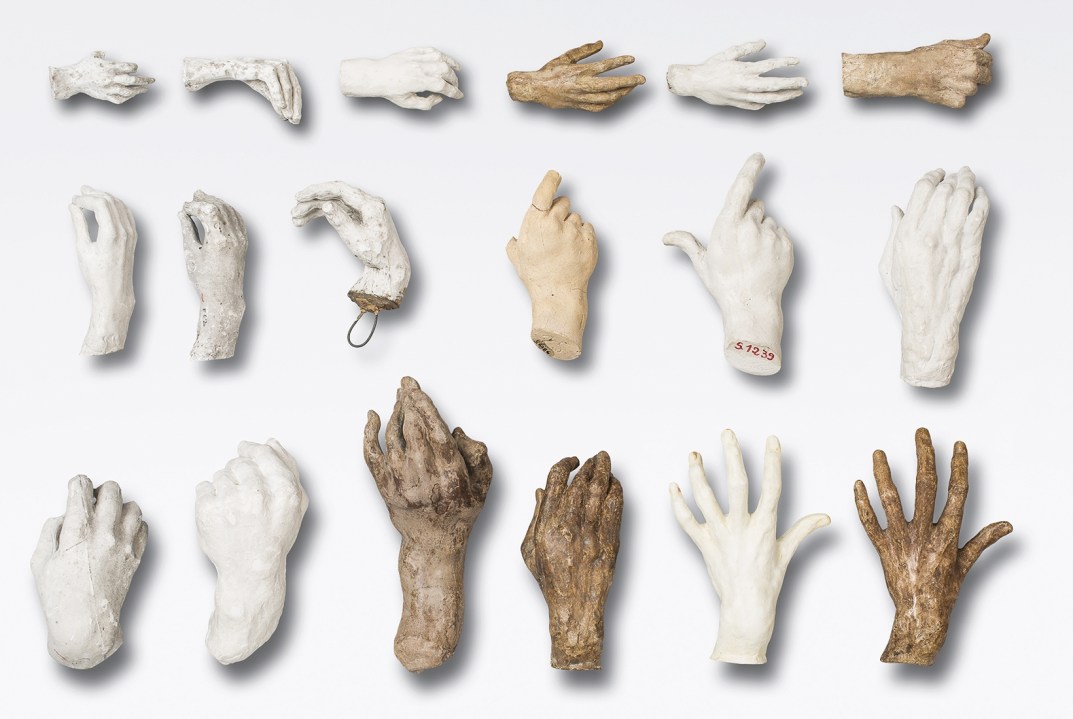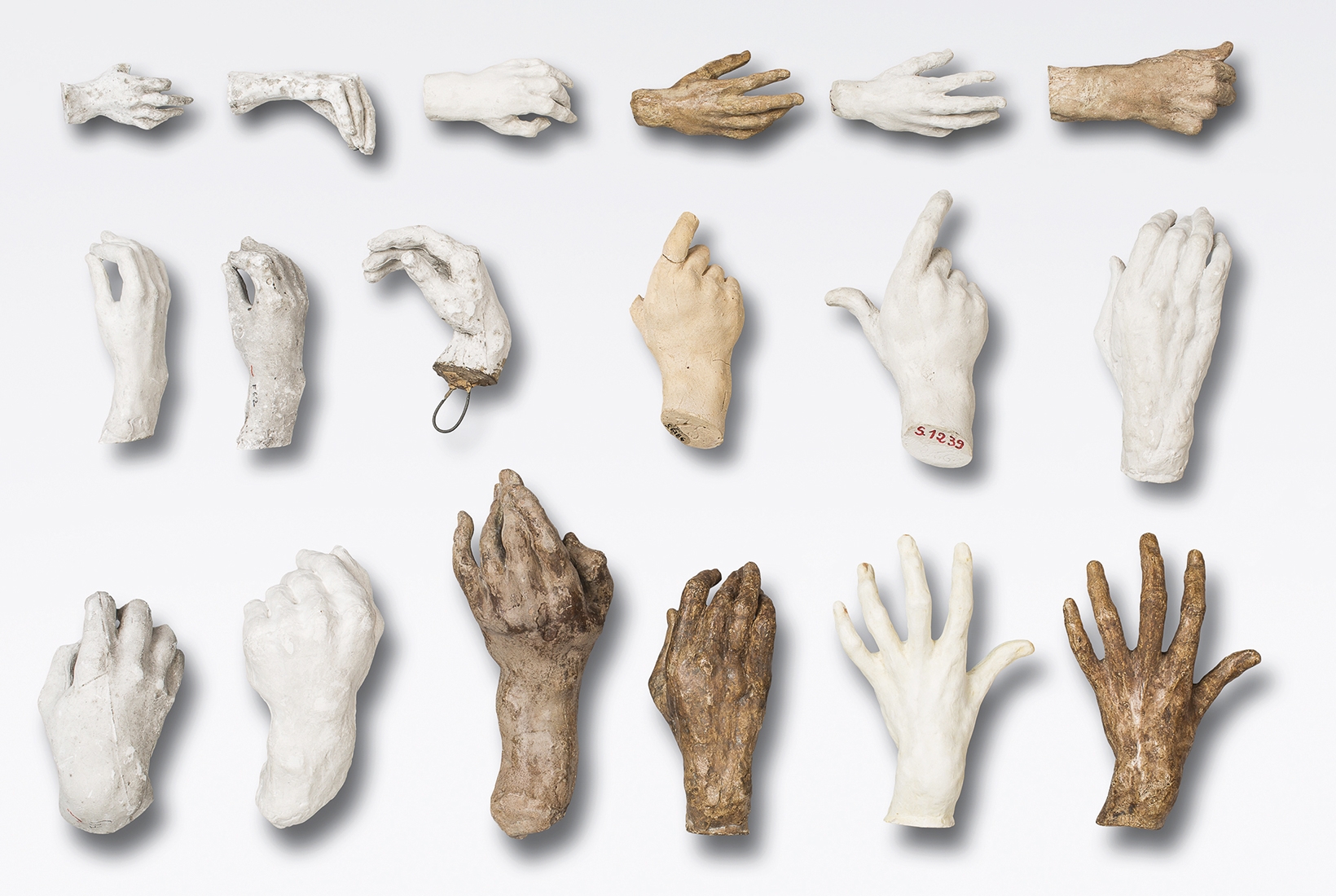Rodin’s studio at Meudon in the suburbs of Paris is huge and filled with light — a sort of combined warehouse, factory and conservatory. It’s crammed with white plaster figures: battered, writhing and fragmentary. This strange, almost surreal effect has been recreated in The Making of Rodin at Tate Modern.
The result is more interesting than beautiful. Few exhibits would normally be classified as finished pieces. Most are plaster casts of clay studies, ranging in scale from miniature to gigantic. Quite a lot aren’t even works in progress, more ingredients for art, bits and pieces he could play around with.
Rodin called these ‘giblets’ (‘abats’). Their effect can be macabre: a severed hand, for example, dangling from a piece of string, like something in a butcher’s window. A whole tray of tiny plaster hands, conversely, seems more like those cabinets of reliquaries filled with holy body parts you see in Mediterranean churches. A study for Balzac’s dressing gown looks very much like an actual, late 19th-century garment soaked in plaster.
It was the endless recycling and repurposing of his ideas that fascinated Rodin
To the sculptor all these were morsels to be fitted together into new wholes, which Rodin did in increasingly wild and imaginative ways as he grew older. ‘The Mask of Camille Claudel and Left Hand of Pierre de Wissant’ (after 1900) combines a beautifully modelled head of his pupil and lover with, attached to one side, a gigantic masculine palm and fingers detached from one of the figures in his ‘Burghers of Calais’.
This juxtaposition brings Magritte and Dali to mind, while being more touching and troubling than either. The male limb caressing, but also huge and powerful; the female head passive and still. The show brings out how for Rodin, a finished work became less and less the point. Clearly it was the endless recycling and repurposing of his ideas that fascinated him, putting them in new relationships with one another.
In his workshop the production process was quasi-industrial (after all, he was a contemporary of Henry Ford as well as of Claude Monet). In that Rodin resembled other successful sculptors. Since Bernini’s day, if not before, they’ve all tended to operate on a light-industrial scale. Quite often, like Rodin, they employed numerous assistants (in his case up to 50). These would enlarge his clay models, transform them into plaster casts, multiply them as many times as he wanted, cast them in bronze or carve them in marble.
In later life Rodin himself would scarcely have picked up a chisel. All that was for skilled craftsmen to do. Rodin’s own contribution was all to do with touch and feel, modelling soft clay with his fingers. Perhaps that was one reason why he was so fascinated by hands.
He faced both forward and back: Rodin was the final major artist in a line that went back through Michelangelo to the Greeks. Simultaneously, he was smashing up the classical tradition and making completely novel kinds of art from the rubble.
This exhibition is a bit austere as an experience — all white, and full of broken arms and bodies — but it makes the point that Rodin was, partly at least, extremely modern. In an unexpected way, he links with Jean Dubuffet, the post-war French artist whose work is on show at the Barbican.
I loved this too, though perhaps I was affected a little by the exhilaration of seeing any exhibitions at all (plus indulging in thrillingly risky behaviour such as travelling on the Circle line). Dubuffet’s life (1901-85) overlapped with Rodin’s more than one might think. But he had an odd career path, working as a wine merchant until he was in his forties, and only then switching full-time to art and emerging as a creative force after the second world war.
Dubuffet explicitly wanted to smash up the specious notion of beauty ‘inherited from the Greeks and cultivated on magazine covers’. Instead of the classical ideal, he loved and studied such alternative modes as graffiti, prehistoric and ‘outsider art’ produced by the eccentric, untrained and mentally ill, all of which he classified as ‘art brut’: raw art, but also with a suggestion that this might be the finer, less sweetened variety (as in Champagne Brut).
The Barbican retrospective and the excellent accompanying book (Prestel) reveal him as a truly exciting artist: radical, adventurous, fizzing with ideas that still look fresh 70 years later. Viewing the show is like watching a crucial part of a puzzle fit into place.
Dubuffet is visibly connected to many aspects of art in the second half of the 20th century, and still today. The fascination with graffiti and outsider art links him to Twombly and Basquiat, Paolozzi and Peter Blake (and, come to think of it, the youthful Hockney). His sensationally thick paint surfaces bring Auerbach and Kossoff to mind. Dubuffet was doing collages with butterflies decades before Hirst. Some of his abstracts look like Jackson Pollock with a tough, streetwise vibe. But beyond all the affinities, it’s the power and visual punch of the best works that really make this such fun. Highly recommended.







Comments